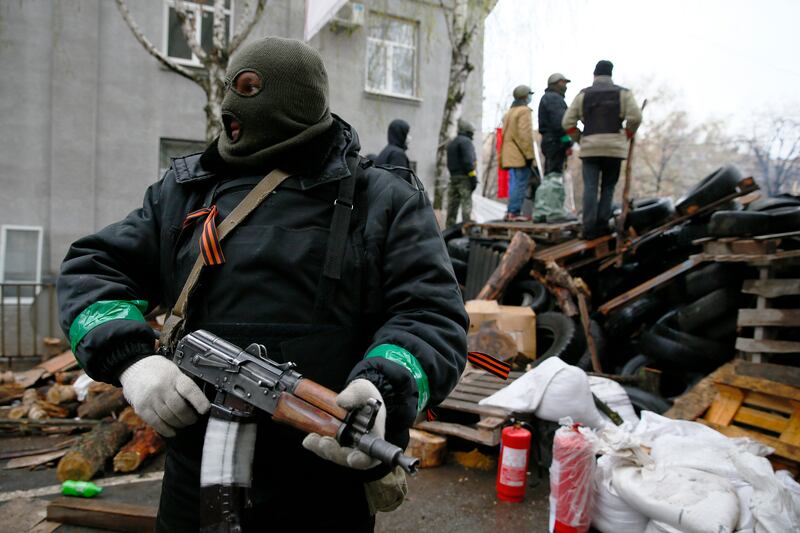SLOVIANSK, Ukraine—The mood on the groundhere was electric today. On Saturday, uniformed, armed men stormed and occupiedthe city’s central police station, demanding secession from Ukraine or at theleast a referendum on joining the Russian Federation. Many of the people here, whoare largely Russian-speaking, watched Russia’s annexation of Crimea in Februarywith joy, and are determined to get their wish, even if it means violence.Meanwhile, the Kiev government accuses Russia of orchestrating the proteststhat have erupted across this region and says it will take action against theprotestors.

I arrived in the city last night with another journalist and made my way directly to the occupied police station. After some initial resistance, we were let in. About 1,000 people were inside the barricades, standing in the streets chanting for Russia and a referendum while a speaker shouted slogans and raised his fist in the air. The crowd of mostly middle-aged couples and single men cheered wildly. A woman insisted on showing us a plate commemorating Soviet World War II heroes that had been given to her grandfather.
But the police station itself it was a different story. Men and youths wearing surgical masks or balaclavas guarded the building and patrolled its immediate vicinity. They were separated from the crowds on the other side of a makeshift barrier of tires and sandbags that had been erected at the top end of the street.
These people were entirely different to those I had met in Donetsk and Luhansk, the other Ukranian cities that have recently become sites of pro-Russian violence. The armed men that form the “self-defense” units here are not just militia carrying bats; they are undoubtedly professionally trained, and though they wear no military insignias, they are clearly soldiers. They carry automatic weapons and wear full army fatigues. They are professional, organized, and ready to fight.
This morning, I tried to get inside theoccupied police station. Rain had fallen heavily overnight and the streets werecaked in sludge. The mounds of tires and sandbags and barbed wire that form thebarricades now dotting the city center had a sodden, depressed look. But thepeople remained as defiant and angry as ever.
This time access was denied. People glaredas I tried to take photos while masked men, again in full military uniform carryingautomatic weapons, ran to and fro. One of them came over to and told us I tostop taking pictures: “Leave now, please!” he bellowed. “Go!” A few members ofthe crown joined him, telling us we weren’t welcome here.
Earlier Sunday, Ukraine’s InteriorMinister, Arsen Avakov, declared that government special forces had beendispatched to the city to clear the building, but the protestors were adamantthat they weren’t going anywhere. A mix of young and old began to form a humanchain across the barricades. There was the usual talk of the “criminal Junta”in Kiev and the glory of Russia, but mostly there was talk of resistance.
The Ukrainian Hyvrna has been in freefallover the last few weeks, and the currency of choice on the streets of Slovianskis rumor. Some said the Special Forces were already here, others said Kievwouldn’t dare come. The overriding feeling was of confused action: people ranup and down the streets shouting to each other to get ready; barricades aroundthe city were fortified even more.
We are now in a new, and dangerous, phasein this crisis. The previous trouble spots of Luhansk and Donetesk are majorcities in Eastern Ukraine, with more organized pro-Russia factions. That theconflict is spreading to small, unimportant towns like Sloviansk is indicative thatpro-Russia activism has taken root in the heartlands of the region.
The war of words between Kiev and Moscow Russianis also intensifying. “The Ukrainian authorities consider the events of the dayas a display of external aggression from Russia,”Interior Minister Arsen Avakov said in a statement this morning. Russian foreignminister Sergei Lavrov hit back almost immediately, claiming the Kievgovernment was “demonstrating its inability to take responsibility for the fateof the country.” The people here claim they will fight, but urge Russia to cometo their aid if they are attacked by the hated Kiev government.
Ukraine’s president, Oleksandr Turchynov,said he will launch a full-scale military operation in the East and vowed therewould be no repetition of Russia’s annexation of Crimea. As of Sunday night,Ukraine had indeed sent security forces to confront the pro-Russian militants, though Western media reports suggested the operation had had little effect in taking back Sloviansk.
This afternoon I heard machine gun fire onSloviansk’s streets as reports came of the first casualties. Many here believethe war has already started and that much, much worse is to come.





